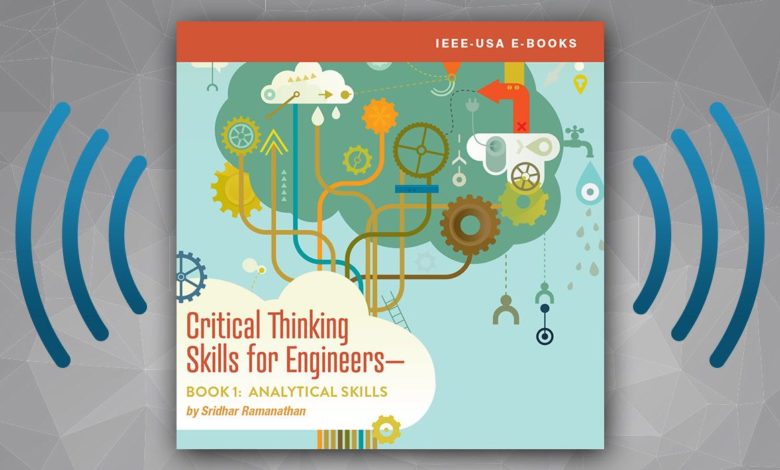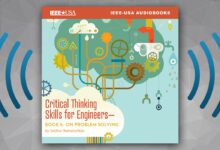

IEEE-USA has released the first book in Sridhar Ramanathan’s five-book series on Critical Thinking Skills for Engineers as an audiobook — allowing it to be downloaded and read while jogging, relaxing at home, or while driving to work. The companion e-book is also available.
Critical Thinking Skills for Engineers: Book 1 Analytic Skills explores the key analytical skills needed to succeed in engineering — including interpreting, analyzing and questioning data; recognizing the similarities and differences of projects; and the desirability of healthy skepticism.
Ramanathan notes that in analyzing a problem there are two extremes, “On the one hand ‘analysis paralysis’ (agonizing too much about too many factors for too long). On the other, is being too impetuous (making a snap judgment based largely on feeling, rather than considered thought).” A good engineer must find the balance.
Ramanathan explains the importance to quality engineering of each skill; then he illustrates his points with relevant, easy-to-understand examples from business, science and government. Drawing on his more than 30 years of experience with technology companies, as well as founding his own marketing agency, Ramanathan offers practical tips, for better ways, for anyone using analytics to solve a problem.
The audio version of Critical Thinking Skills for Engineers: Analytic Skills is available and free to all.
Ramanathan points out that the first thing to do when using analytics is to “Ask the right questions, so that you focus engineers/staff on solving the right problem.” He gives the example of a marketing manager coming to the VP of Engineering and asking, “How can we increase battery capacity by 25 percent in our smartphone?”
Some engineers might put pencil to paper and start tackling the problem. However, a better approach, Ramanathan suggests, is to step back and ask: Is this the right question? Maybe a better problem statement is: How can our customers decrease the frequency of needing to charge their phone? With this problem statement, various new approaches are open to explore: seeing what apps were draining batteries the most, and working on how to decrease their energy consumption; changing users’ behaviors (for instance, turning down the brightness, or deleting unused apps); or even adding a small solar panel on the phone, so it can charge while in use.
After focusing on the right question, Ramanathan then discusses good practices, such as ensuring analysis is not confusing causation and correlation; how to gather information from people, documents and data; and some of the common pitfalls of analysis, including confirmation bias.
In the chapter on Questioning Evidence, Ramathan gives an illustration about how others do not always welcome such questioning.
Ramanathan details how in 1925, Ph.D. candidate Cecilia Payne-Gaposchkin did an analysis of the spectral data of the sun, concluding that that the sun and earth had drastically different composition — the sun having large concentrations of hydrogen and helium. Her advisor and other scholars rejected her findings, sticking to the conventional views that the earth and sun had similar composition. It was another five years before another paper was published confirming Payne-Gaposchkin analysis and several years more before the majority of scientists accepted the sun as a burning ball of mostly hydrogen gas.
Ramanathan’s tip for this section: “When examining evidence, consider the possibility that a startling new insight lies hidden in the data set — one just waiting to be revealed — by applying a fresh new lens, or perspective.”
Close cousin to questioning of evidence is remaining skeptical and trusting your instinct when one senses a problem with the data, or how the data is being interpreted. This skepticism can make all the difference and, as Ramanathan illustrates, even sometimes saves lives.
In WWII, Navy statisticians were analyzing the bullet holes in planes returning from battle. Based on the analysis, the statisticians recommended those areas with the highest concentration of holes be reinforced. Something didn’t sit right with Abraham Wald, a Hungarian mathematician. He argued their approach was wrong. He realized the charts they had made were of where a plane could be hit and not destroyed. It was the areas that had no bullet holes that needed reinforcements — for when these areas had been hit, the planes did not make it back to base. The Navy changed the areas they reinforced, and began to lose significantly less aircraft in battle. Ramanathan adds that an engineer must follow Wald’s example and ask, “What is the intrinsic bias or limitation of the data that might skew my conclusions?”
Ramanathan recommends engineers ask questions to maintain a healthy sense of skepticism, such as: Does data contain bias?; Are conclusions drawn from the data based more on beliefs, than on hard evidence?; What unpopular opinion might be worth exploring?; and, Do conclusions flow logically from the data?
In the chapter on recognizing differences and similarities, Ramanathan goes through the invention of Kevlar, and the creation of Atlassian (a software collaboration company), before concluding with “There is power in differences. As an engineer…the challenge is to press hard to build something that is unique, different and individualized from competing solutions.”
The book is a great listen — or read — and creates a strong foundation for the other books in the Critical Thinking Skills for Engineers series. The other books deal with communication skills, open-mindedness, creativity and problem solving. For the audiobook, go to https://ieeeusa.org/shop/audiobooks/
The entire series is also available as e-books at https://ieeeusa.org/shop
Paul Lief Rosengren is the coauthor of In the Time of Covid: One Hospital’s Struggles and Triumphs. He worked for more than three decades in communications at NBC, PSE&G, and in state government. Rosengren has a Master’s in Public Policy from The Kennedy School of Government, Harvard; and an undergraduate degree in political science from Dickinson College.






